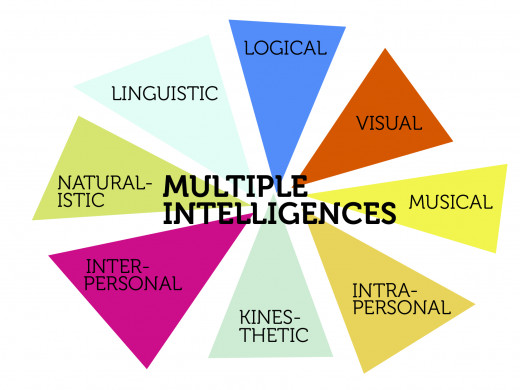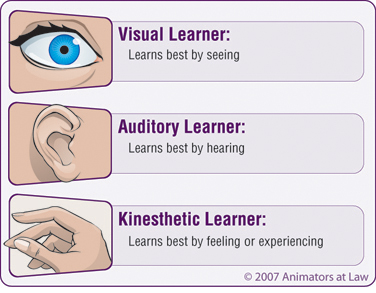Multiple Intelligences

Learning Theories
Throughout the years there have been many different theories related to a person's ability to learn and process new information. It has always been apparent that some individuals are able to learn faster than others, but the question is why? Howard Gardner, proposed the theory of multiple intelligences. He believed that each person had nine specific types of intelligence, some of which were more dominant than others. In order to effectively reach a group of students, we would have to incorporate each aspect into our teaching. Let's take a look at the nine intelligences described by Howard Gardner, the importance in recognizing these intelligences, and how technology can be used as a tool to reach multiple intelligences and enhance our teaching and learning.

Linguistic Intelligence
Linguistic intelligence is associated with being "word smart" or "learning through the spoken and written word" (McKenzie, 1999) . Every day we have the ability to learn from the spoken word and/or written word. Whether it is through a book that we have read, an article someone posted to their profile, or listening to a teacher or coworker while going about our daily activities. Without linguistic intelligence, a person's ability to learn would be severely impaired.
Logical-Mathematical Intelligence
Another type of intelligence that is recognized would be our logical-mathematical intelligence. Our logical-mathematical intelligence is our ability to learn "through reasoning and problem solving" (McKenzie, 1999). Those who have dominant skills in this intelligence would find problem solving easy and could probably work math equations quickly and possibly in their head. There is usually a logical sequence for working out problems, and these are usually the people who find the quickest solutions.
Musical Intelligence
Other individuals may possess a large amount of musical intelligence. Musical intelligence is considered to be a special skill that only a select few are able to fully embrace. It is amazing how music is able to portray feelings in dramatic and original works of art. It has the ability to make us feel the meanings and understand the personality of the song. Many people are able to learn music, however, it is the people who do not need to be taught who are remembered the longest. They are able to hear the pitch, feel the rather, and hold the tune without any assistance at all.
Spatial Intelligence
Spatial intelligence is the "skill in thinking in pictures and visioning abstractly" (Lever-Duffy & McDonald, 2011). Some people have the need to see things in order to learn the process. Demonstrations are a good example of this style of learning because we are seeing the steps and are able to soak in the information from a visual aspect. A person who has a strong amount of spatial intelligence would have the " ability to "see" things" and piece them together inside their head create a plan or solve a problem" (McKenzie, 1999). Most artists and painters are well equipped with spatial intelligence.
Kinesthetic Intelligence
Bodily kinesthetic intelligence is the capacity to learn while using your body. Hands on learning is a style that requires us to use our kinesthetic intelligence to learn new skills. This is an important part of the learning process for many individuals. However, the combination of different learning styles and techniques helps individuals understand the big picture.

Interpersonal Intelligence
Our interpersonal intelligence is "the ability to understand other people and use this knowledge to achieve goals" (Lever-Duffy & McDonald, 2011). Our interpersonal skills are extremely important in the business world. Most of us have bosses, teachers, parents, and many other people who are constantly trying to communicate their desires and needs for us to understand. Our interpersonal skills are defined with how well we are able to interpret the wishes of others through communication.
Also recognized is our intrapersonal intelligence that derives from our "ability to form an accurate internal representation of self" (Lever-Duffy & McDonald, 2011). Our intrapersonal decisions are usually governed by our feelings, values, morals, or other deep realizations. Our intrapersonal intelligence is displayed by how well we handle situations and the emotion displayed when presenting information.
Naturalistic & Existential Forms of Intelligence
The last two intelligences that are associated with Howard Gardner are the naturalistic and existential forms of intelligence. Of course, our naturalistic intelligence deals with how atoned we are with the world and nature that surrounds us. Our existential intelligence is the "ability to consider and deal with questions of human existence" (Lever-Duffy & McDonald, 2011).
"If one adopts the multiple-intelligences approach, then learning will be affected by the dominance of one or more of the intelligences in each individual student" (Lever-Duffy & McDonald, 2011). A teacher would need to incorporate different techniques into his or her learning plan in order to reach people using a combination of various learning styles. A good educator realizes the importance of diversity not only in the classroom, but also in the presentation of information. Students perceive things using different cognitive (thinking) processes and learn using different learning styles. Once we factor in the fact that students all vary in intelligence (IQ) level, it is almost necessary that all individuals have a unique class designed for their specific needs. Educators are irreplaceable because they are able to meet the needs of many different individuals by getting to know them and bending the lesson to fit all individuals.
Technology plays an important role in helping teachers get the message out to a broad and diverse audience. Technology is a wonderful tool that has made educating a lot more effective, fun, and efficient. We are able to do things today that we would have never imagined one hundred years ago. The best part of using technology to teach is the power technology has to make the lesson memorable, understandable, and educational at the same time.
Howard Gardner developed an accurate theory that has helped teachers understand the needs of their learners. It is up to us to be able to help our students reach their full potential by maximizing their learning process. Reaching out to people using the nine techniques described throughout this paper will help us develop lessons that will reach the masses. We should at least be able to help a few people better understand the content. Teachers who are able to recognize the learning needs of the student and use technology as a tool will help many people as they grow in skill and knowledge that will better prepare them for the future.
References
Lever-Duffy, J. & McDonald, J. B. (2011). Teaching and learning with technology (4th ed.). Boston, MA: Pearson Education, Inc./Allyn & Bacon.
McKenzie, Walter (1999). It's not how smart you are, it's how you are smart. Retrieved August 01, 2011 from http://surfaquarium.com/MI/overview.htm
Multiple Intelligences: Seven Ways to Approach Curriculum", Educational Leadership, November, 1994. Retrieved August 01, 2011 from http://www.thomasarmstrong.com/articles/7_ways.php
State of the Art (Producer). (1997). Big thinkers: Howard Gardner on multiple intelligences [Video file]. Edutopia. Retrieved August 01, 2011 from http://www.edutopia.org/multiple-intelligences-howard-gardner-video









